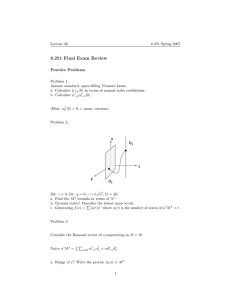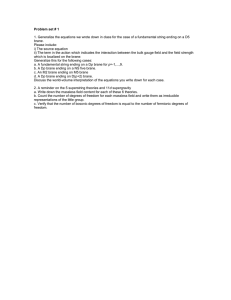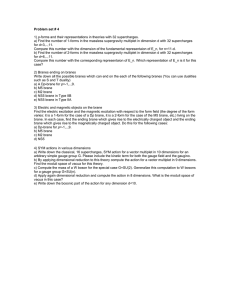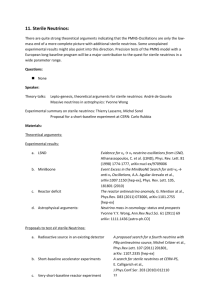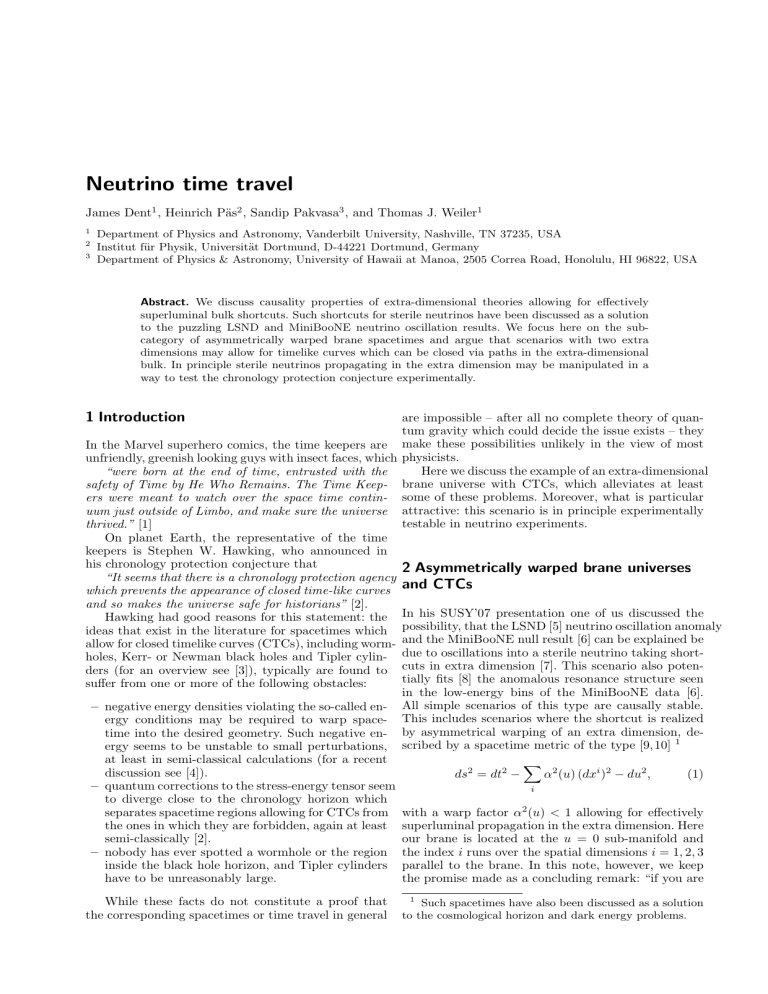
Neutrino time travel James Dent1 , Heinrich Päs2 , Sandip Pakvasa3 , and Thomas J. Weiler1 1 2 3 Department of Physics and Astronomy, Vanderbilt University, Nashville, TN 37235, USA Institut für Physik, Universität Dortmund, D-44221 Dortmund, Germany Department of Physics & Astronomy, University of Hawaii at Manoa, 2505 Correa Road, Honolulu, HI 96822, USA Abstract. We discuss causality properties of extra-dimensional theories allowing for effectively superluminal bulk shortcuts. Such shortcuts for sterile neutrinos have been discussed as a solution to the puzzling LSND and MiniBooNE neutrino oscillation results. We focus here on the subcategory of asymmetrically warped brane spacetimes and argue that scenarios with two extra dimensions may allow for timelike curves which can be closed via paths in the extra-dimensional bulk. In principle sterile neutrinos propagating in the extra dimension may be manipulated in a way to test the chronology protection conjecture experimentally. 1 Introduction are impossible – after all no complete theory of quantum gravity which could decide the issue exists – they In the Marvel superhero comics, the time keepers are make these possibilities unlikely in the view of most unfriendly, greenish looking guys with insect faces, which physicists. Here we discuss the example of an extra-dimensional “were born at the end of time, entrusted with the safety of Time by He Who Remains. The Time Keep- brane universe with CTCs, which alleviates at least ers were meant to watch over the space time contin- some of these problems. Moreover, what is particular uum just outside of Limbo, and make sure the universe attractive: this scenario is in principle experimentally testable in neutrino experiments. thrived.” [1] On planet Earth, the representative of the time keepers is Stephen W. Hawking, who announced in his chronology protection conjecture that 2 Asymmetrically warped brane universes “It seems that there is a chronology protection agency and CTCs which prevents the appearance of closed time-like curves and so makes the universe safe for historians” [2]. Hawking had good reasons for this statement: the In his SUSY’07 presentation one of us discussed the ideas that exist in the literature for spacetimes which possibility, that the LSND [5] neutrino oscillation anomaly allow for closed timelike curves (CTCs), including worm- and the MiniBooNE null result [6] can be explained be holes, Kerr- or Newman black holes and Tipler cylin- due to oscillations into a sterile neutrino taking shortders (for an overview see [3]), typically are found to cuts in extra dimension [7]. This scenario also potentially fits [8] the anomalous resonance structure seen suffer from one or more of the following obstacles: in the low-energy bins of the MiniBooNE data [6]. – negative energy densities violating the so-called en- All simple scenarios of this type are causally stable. ergy conditions may be required to warp space- This includes scenarios where the shortcut is realized time into the desired geometry. Such negative en- by asymmetrical warping of an extra dimension, deergy seems to be unstable to small perturbations, scribed by a spacetime metric of the type [9,10] 1 at least in semi-classical calculations (for a recent X discussion see [4]). ds2 = dt2 − α2 (u) (dxi )2 − du2 , (1) – quantum corrections to the stress-energy tensor seem i to diverge close to the chronology horizon which separates spacetime regions allowing for CTCs from with a warp factor α2 (u) < 1 allowing for effectively the ones in which they are forbidden, again at least superluminal propagation in the extra dimension. Here semi-classically [2]. our brane is located at the u = 0 sub-manifold and – nobody has ever spotted a wormhole or the region the index i runs over the spatial dimensions i = 1, 2, 3 inside the black hole horizon, and Tipler cylinders parallel to the brane. In this note, however, we keep have to be unreasonably large. the promise made as a concluding remark: “if you are While these facts do not constitute a proof that the corresponding spacetimes or time travel in general 1 Such spacetimes have also been discussed as a solution to the cosmological horizon and dark energy problems. Flavor Physics Contributed Talk "our brane" br an el ig h tc on e e on O B B’ Lorentz boost tc h ig el an br B v>0 u>0 B’ t O O’ x u=0 x v u Fig. 1. Closed timelike curve in an asymmetrically warped universe: (i) A signal takes a space-like shortcut via a path of constant u = u0 with v = 0 from point O to point B. (ii) A Lorentz boost transforms B into B ′ with negative time coordinate. (iii) A return shortcut at constant v = v0 with u = 0 closes the timelike curve. desperate to have a neutrino time machine I’ll get you our brane. In the limit u1 ≪ α1−1 t, which is always one.” fulfilled for sufficiently large t, the reentry point on our In order to do so we consider two asymmetrically brane is B µ ≈ (t, x = α1−1 t, u = 0). Since the distance warped extra dimensions “u” and “v” with warp fac- to the reentry point B µ is space-like (i.e. outside the tors α(u) and η(v), respectively [11]. We assume that brane’s lightcone), it may be transformed to negative the u- and v dimensions assume the simple form (1) time by a boost on our brane. The boosted point B ′µ in different Lorentz frames. Note that this is natural has coordinates ¡ ¢ ¡ ¢ for any spacetime with two or more extra dimensions, x′ = γ t α1−1 − β , t′ = γ t 1 − βα1−1 . (3) as there is no preferred Lorentz frame from the viewpoint of the brane. In the following we construct this It is clear that for 6-dimensional metric explicitly. We denote the relative 0 < α1 < β < 1 (4) velocity between the two Lorentz frames, in which the u and v dimensions assume the simple form (1) as βuv . an observer in the boosted frame on our brane sees It is easy to show, then, that the full 6-dimensional the signal arrive in time with t′ < 0, i.e., before it metric assumes the form was emitted. However, this result alone does not imply £ any conflict with causality. In particular, it does not 2 2 2 2 2 2 ds = γ (1 − βuv η (v))dt − 2βuv α(u)(η (v) − 1)dxdt necessarily imply that the spacetime is blessed with ¤ 2 −α2 (u)(η 2 (v) − βuv )dx2 − du2 − dv 2 . (2) CTCs. To close the timelike curve, one has to show that the time t′ during which the signal traveled backFor v = 0 (2) reduces to (1), for u = 0 (2) reduces wards in time, is sufficiently large to allow a return to (1) boosted by βuv , and for u = v = 0, i.e. on from the spacetime point B ′µ = (t′ , (x = α−1 t)′ , 0) to the brane, to 4-dimensional Minkowski spacetime. By the spacetime point of origin, O = O′ = (0,1 0, 0). The boosting the metric (2) with β = −βuv the v-dimension speed required to close the lightlike curve of the signal, assumes the simple form (1) and the metric for the u- as seen by the boosted observer on the brane, is dimension becomes non-diagonal. If the x coordinate would be periodic, the u = 0 1 − βα1 (x = α1−1 t)′ ′ = , (5) c = req ′ slide of the metric (2) would allow for a simple map|t | β − α1 ping into the Tipler-van-Stockum spacetime, which is well known to accommodate CTCs [12]. However, in where the latter expression results from using (3). It that the condition 0 < α1 < β < 1 the case of a boosted asymmetrically warped extra is easy to show ′ dimension, the variable x is not periodic (unless our implies that creq itself is superluminal. Thus there is universe has the topology of a flat torus). It is thus no return path on our brane which leads to a CTC. We now benefit from the fact that the spacetime required to construct an explicit return path to the considered has two extra dimensions and that we have spacetime point of origin. the possibility to use the v dimension to chose an alIn the following we consider a signal following a path from the boosted point B ′ to O, particular path as given in Fig. 1. The signal leaves our ternative return ′ ′ allowing for |c bulk | > |creq |. For simplicity we choose brane at the spacetime point O = (t = 0, x = 0, u = 0), β = −β and the return path in the u = 0, v > 0 uv and propagates on the hypersurface at u1 for a travel −1 −1 plane, where the x − v slice of the metric takes the time t with the limiting velocity (α(u1 )) ≡ α1 . simple form (1). Now any suitably chosen warp facWe will assume that 0 < α1 < 1, so that the travel −1 ≥ c′req in combination with speeds in the bulk is superluminal relative to travel tor η(v) with (η(v0 )) speed on our metric. At time t, the signal may reenter βuv > α(u0 ) generates a CTC. H. Päs, S. Pakvasa, T.J. Weiler G 00 Neutrino time trave 6 G jj 4 400 300 2 200 0 -2 100 -4 0 -6 -4 G uu -2 0 2 -4 4 G vv 3 2.5 -2 0 2 4 0 2 4 6 4 2 2 1.5 0 1 -2 0.5 -4 0 -4 -2 0 2 -6 4 -4 -2 Fig. 2. Nonzero elements of the Einstein tensor G on the v = 0 slice, as a function of u, for warp factors α(u) = 1/(u2 + c2 ) and η(v) = 1/(v 4 + c2 ), with c = 1. While the null, weak and dominant energy conditions are violated in the bulk, they are conserved on the brane. µν 3 Stress energy tensor, energy conditions and other pathologies In view of the stability pathologies related to requirement of negative energy densities for spacetimes with CTCs known in the literature, it is interesting to analyze, whether the stress-energy tensor Tµν = 1 Gµν 8 π GN (6) for the extra-dimensional metric (2) fulfills the energy conditions. The null, weak, strong and dominant energy conditions are defined as follows, NEC : ρ + pj ≥ 0 WEC : ρ ≥ 0 SEC : ∀j, ∀j; and ∀j, (7) ρ + pj ≥ 0; (8) ρ + pj ≥ 0 and ρ + Σj pj ≥ 0; (9) DEC : ρ ≥ 0 and ∀j, pj ∈ [ρ, −ρ]. (10) While it is in principle straightforward to calculate the Christoffel symbols the general expressions for the metric (2) are complicated. Thus we constrained ourselves to a numerical analysis of specific examples for the warp factors α(u) and η(v). It is not difficult to find a functional form for the warp factors α and η , which conserves some of the energy conditions, at least on the brane. One such example is given by α(u) = 1/(u2 + c2 ) and η(v) = 1/(v 4 + c2 ). For this case the elements of the Einstein tensor on the v = 0-slice are shown as a function of u in Fig. 2. The null, weak and dominant energy conditions are conserved on the brane, while the strong energy condition is violated on the brane (see Fig. 2). This property favors the brane scenarios discussed over most previous examples of spacetimes with CTCs. Moreover, one could argue that also instabilities due to quantum corrections are less likely to diverge in a spacetime of higher dimension. Finally, due to the ubiquity of the extra dimension this scenario has the particular advantage that the ambiguity due to the lack of a full quantum gravity treatment of the problem can be solved: it allows - at least in principle - for an experimental test. 4 Neutrino time machine As mentioned before, a natural and well motivated candidate for a bulk fermion in string theory is an SU(2) singlet “sterile” neutrino. In many particle theories, these sterile neutrinos would mix with the Standard Model neutrinos, and will be generated by neutrino oscillations when neutrinos propagate in space and time. Sterile neutrinos thus provide an accessible probe for the causality properties of extra dimensions. An experiment testing for such properties of spacetime could effectively transform active neutrinos into sterile neutrinos by using the resonant conversion in an increasing matter density known as MikheevSmirnov-Wolfenstein (MSW) [13,14] effect. A neutrino beam of suitably chosen energy could be generated in a beam-dump experiment at one of the Earth’s poles and pointed into the ground, traversing a pit with a slowly changing matter density profile. Once being converted inside the Earth’s core, the sterile neutrinos will avail shortcuts in extra dimension to minimize the action of Flavor Physics the propagation path, and thus effectively propagate a spacelike distance. On their way out of the Earth’s interior the sterile neutrinos are reconverted into active flavors, which could be observed by a neutrino detector at the equator. If the neutrinos have advanced a spacelike distance, the Earth’s spin at the equator will transform the signal into a moving reference frame and thus reverse the order of emission and detection. It could be possible to send the signal back to the point of origin (the pole lab) before it had been sent off. Contributed Talk 12. F. J. Tipler, Phys. Rev. D 9, (1974) 2203. 13. S. P. Mikheev and A. Y. Smirnov, Sov. J. Nucl. Phys. 42, (1985) 913. 14. L. Wolfenstein, Phys. Rev. D 17, (1978) 2369. 5 Conclusions In this paper we discussed the causality properties of brane universes with two asymmetrically warped extra dimensions. Such scenarios are attractive in view of the LSND and MiniBooNE anomalies, as well as due to their potential to solve or alleviate the cosmological horizon and dark energy problems. We have shown that rather generic examples of such spacetimes have closed timelike curves without violating the null, weak and dominant energy conditions on the brane. Moreover, neutrino oscillations may provide a unique possibility to test Hawking’s chronology protection conjecture, should such spacetimes really be realized in Nature. We conclude that neutrinos might not only serve as a probe for physics beyond the Standard model and cosmology, but also for the understanding of the deepest foundations of causality and time. Acknowledgements JD and TJW were supported by the US Department of Energy under Grant DE-FG05-85ER40226. HP was supported by the the University of Alabama and the EU project ILIAS N6 WP1. SP was supported by the US Department of Energy under Grant DE-FG0204ER41291. References 1. 2. 3. 4. 5. 6. 7. 8. 9. 10. 11. http://www.marvunapp.com/Appendix/timekeepers.htm S. W. Hawking, Phys. Rev. D 46, (1992) 603. M. Visser, arXiv:gr-qc/0204022. R. V. Buniy and S. D. H. Hsu, Phys. Lett. B 632, (2006) 127. C. Athanassopoulos et al. [LSND Collaboration], Phys. Rev. Lett. 77, (1996) 3082. A. A. Aguilar-Arevalo et al. [The MiniBooNE Collaboration], Phys. Rev. Lett. 98, (2007) 231801. H. Päs, S. Pakvasa and T. J. Weiler, Phys. Rev. D 72, (2005) 095017. V. Barger, P. Huber, J. Learned, D, Marfatia, H. Päs, S. Pakvasa and T. J. Weiler, to be published. D. J. H. Chung and K. Freese, Phys. Rev. D 62, (2000) 063513. C. Csaki, J. Erlich and C. Grojean, Nucl. Phys. B 604, (2001) 312. J. Dent, H. Päs, S. Pakvasa and T. J. Weiler, grqc/0603045v2, to be published.
